Science & Environment
Nature decline is now nearing dangerous tipping points, WWF warns
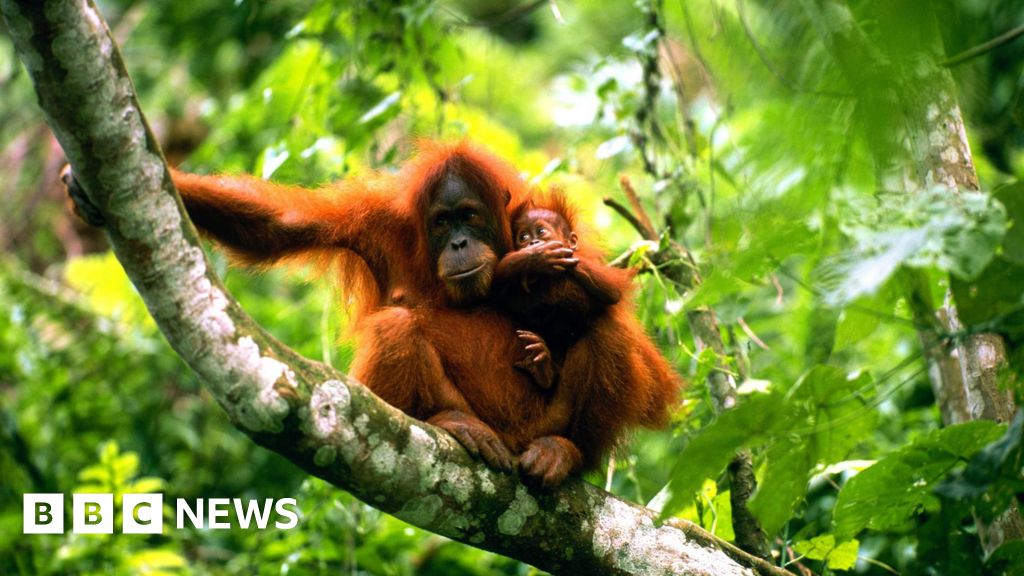
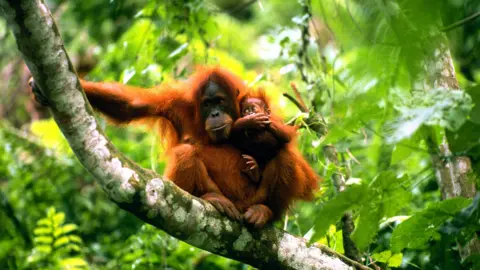 Getty Images
Getty ImagesHuman activity is continuing to drive what conservation charity the World Wide Fund for Nature (WWF) calls a “catastrophic” loss of species.
From elephants in tropical forests to hawksbill turtles off the Great Barrier Reef, populations are plummeting, according to a stocktake of the world’s wildlife.
The Living Planet Report, a comprehensive overview of the state of the natural world, reveals global wildlife populations have shrunk by an average of 73% in the past 50 years.
The loss of wild spaces was “putting many ecosystems on the brink”, WWF UK head Tanya Steele said, and many habitats, from the Amazon to coral reefs, were “on the edge of very dangerous tipping points”.
 © Shutterstock / COULANGES / WWF-Sweden
© Shutterstock / COULANGES / WWF-SwedenThe report is based on the Living Planet Index of more than 5,000 bird, mammal, amphibian, reptile and fish population counts over five decades.
Among many snapshots of human-induced wildlife loss, it reveals 60% of the world’s Amazon pink river dolphins have been wiped out by pollution and other threats, including mining and civil unrest.
It also captured hopeful signs of conservation success.
A sub-population of mountain gorillas in the Virunga Mountains of East Africa increased by about 3% per year between 2010 and 2016, for example.
But the WWF said these “isolated successes are not enough, amid a backdrop of the widespread destruction of habitats”.
Tom Oliver, professor of ecology at the University of Reading, who is unconnected with the report, said when this information was combined with other datasets, insect declines for example, “we can piece together a robust – and worrying – picture of global biodiversity collapse”.
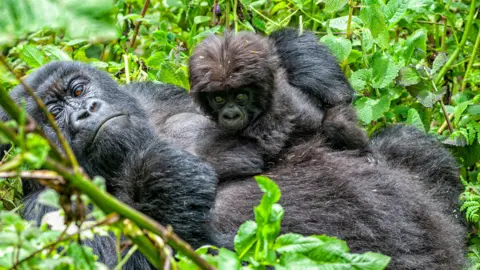 Getty Images
Getty ImagesThe report found habitat degradation and loss was the biggest threat to wildlife, followed by overexploitation, invasive species, disease, climate change and pollution.
Lead author and WWF chief scientific adviser Mike Barrett said through human action, “particularly the way that we produce and consume our food, we are increasingly losing natural habitat”.
The report also warns nature loss and climate change are fast pushing the world towards irreversible tipping points, including the potential “collapse” of the Amazon rainforest, whereby it can no longer lock away planet-warming carbon and mitigate the impacts of climate change.
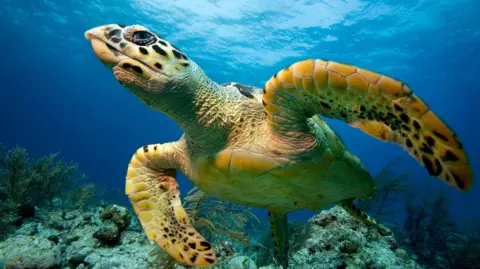 Getty Images
Getty Images“Please don’t just feel sad about the loss of nature,” Mr Barrett said.
“Be aware that this is now a fundamental threat to humanity and we’ve really got to do something now.”
Valentina Marconi, from the Zoological Society of London’s Institute of Zoology, told BBC News the natural world was in a “precarious position” but with urgent, collective action from world leaders “we still have the chance to reverse this”.
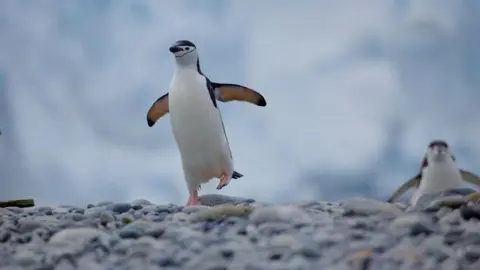 © WWF-Aus / Chris Johnson
© WWF-Aus / Chris Johnson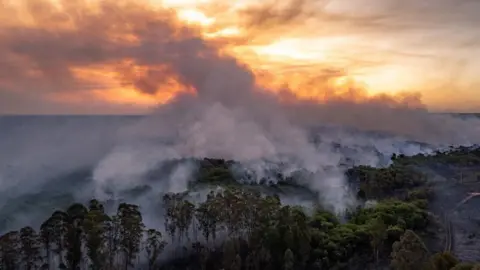 © Jacqueline Lisboa / WWF-Brazil
© Jacqueline Lisboa / WWF-BrazilMs Steele said the report was an “incredible wake-up call”.
“Healthy ecosystems underpin our health, prosperity and wellbeing,” she told BBC News.
“We don’t think this sits on the shoulders of the average citizen – it’s the responsibility of business and of government.
“We need to look after our land and our most precious wild places for future generations.”
Science & Environment
Shackleton’s lost ship as never seen before
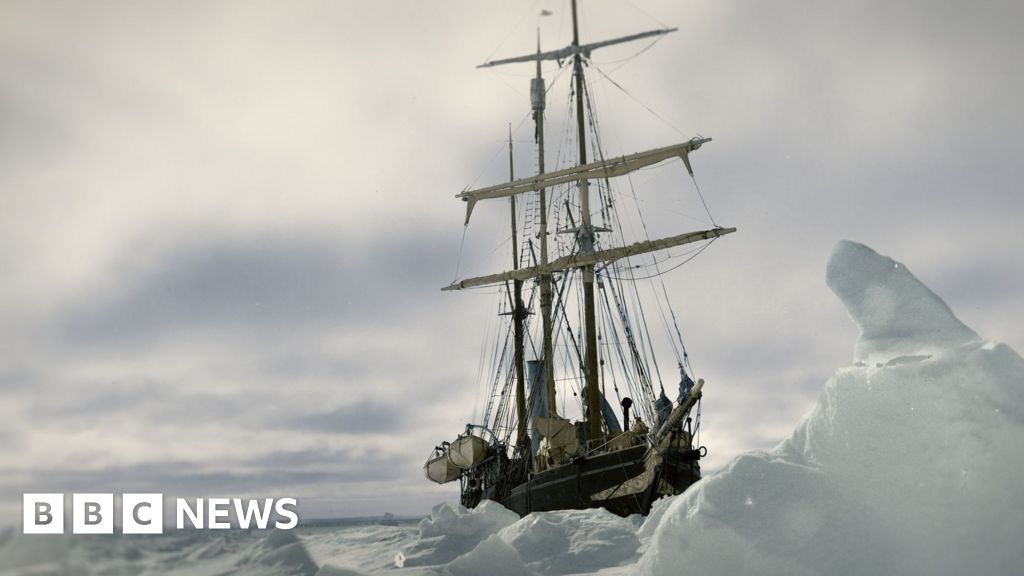
After more than 100 years hidden in the icy waters of Antarctica, Sir Ernest Shackleton’s ship Endurance has been revealed in extraordinary 3D detail.
For the first time we can see the vessel, which sank in 1915 and lies 3,000m down at the bottom of the Weddell Sea, as if the murky water has been drained away.
The digital scan, which is made from 25,000 high resolution images, was captured when the ship was found in 2022.
It’s been released as part of a new documentary called Endurance, which will be shown at cinemas.
The team has scoured the scan for tiny details, each of which tell a story linking the past to the present.
In the picture below you can see the plates that the crew used for daily meals, left scattered across the deck.
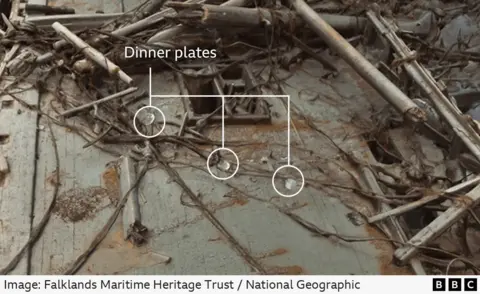 Falklands Maritime Heritage Trust / National Geographic
Falklands Maritime Heritage Trust / National GeographicIn the next picture there’s a single boot that might have belonged to Frank Wild, Shackleton’s second-in-command.
 Falklands Maritime Heritage Trust / National Geographic
Falklands Maritime Heritage Trust / National GeographicPerhaps most extraordinary of all is a flare gun that’s referenced in the journals the crew kept.
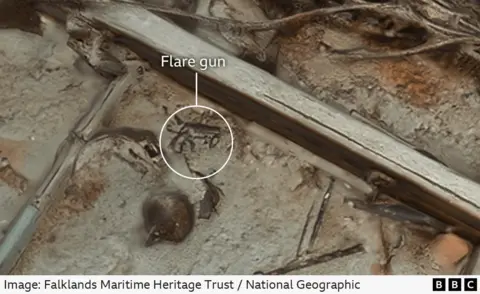 Falklands Maritime Heritage Trust / National Geographic
Falklands Maritime Heritage Trust / National GeographicThe flare gun was fired by Frank Hurley, the expedition’s photographer, as the ship that had been the crew’s home was lost to the ice.
“Hurley gets this flare gun, and he fires the flare gun into the air with a massive detonator as a tribute to the ship,” explains Dr John Shears who led the expedition that found Endurance.
“And then in the diary, he talks about putting it down on the deck. And there we are. We come back over 100 years later, and there’s that flare gun, incredible.”
A doomed mission
Sir Ernest Shackleton was an Anglo-Irish explorer who led the Imperial Trans-Antarctic Expedition, which set out to make the first land crossing of Antarctica.
But the mission was doomed from the outset.
Endurance became stuck in pack ice within weeks of setting off from South Georgia.
The ship, with the crew on board, drifted for months before the order was eventually given to abandon ship. Endurance finally sank on 21 November 1915.
Shackleton and his men were forced to travel for hundreds of miles over ice, land and sea to reach safety – miraculously all 27 of the crew survived.
Their extraordinary story was recorded in their diaries, as well as in Frank Hurley’s photographs, which have had colour added for the Endurance documentary.
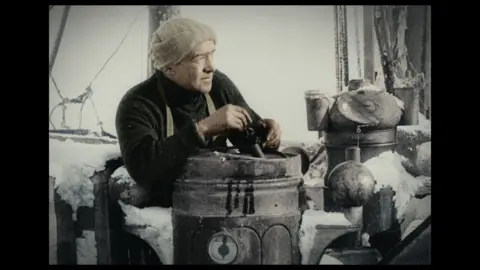 BFI/Frank Hurley
BFI/Frank HurleyThe ship itself remained lost until 2022.
Its discovery made headlines around the world – and the footage of Endurance revealed that it is beautifully preserved by the icy waters.
The new 3D scan was made using underwater robots that mapped the wreck from every angle, taking thousands of photographs. These were then “stitched” together to create a digital twin.
While footage filmed at this depth can only show parts of Endurance in the gloom, the scan shows the complete 44m long wooden wreck from bow to stern – even recording the grooves carved into the sediment as the ship skidded to a halt on the seafloor.
The model reveals how the ship was crushed by the ice – the masts toppled and parts of the deck in tatters – but the structure itself is largely intact.
Shackleton’s descendants say Endurance will never be raised – and its location in one of the most remote parts of the globe means visiting the wreck again would be extremely challenging.
But Nico Vincent from Deep Ocean Search, who developed the technology for the scans, along with Voyis Imaging and McGill University, said the digital replica offers a new way to study the ship.
“It’s absolutely fabulous. The wreck is almost intact like she sank yesterday,” said Mr Vincent, who was also a co-leader for the expedition.
He said the scan could be used by scientists to study the sea life that has colonised the wreck, to analyse the geology of the sea floor, and to discover new artefacts.
“So this is really a great opportunity that we can offer for the future.”
The scan belongs to the Falklands Maritime Heritage Trust who also funded and organised the expedition to find Shackleton’s ship.
The Endurance documentary is premiering at the London Film Festival on 12 October and will be released in cinemas in the UK on 14 October.
Additional reporting Kevin Church
Science & Environment
Mama bear beats rival who killed her cub to become winner
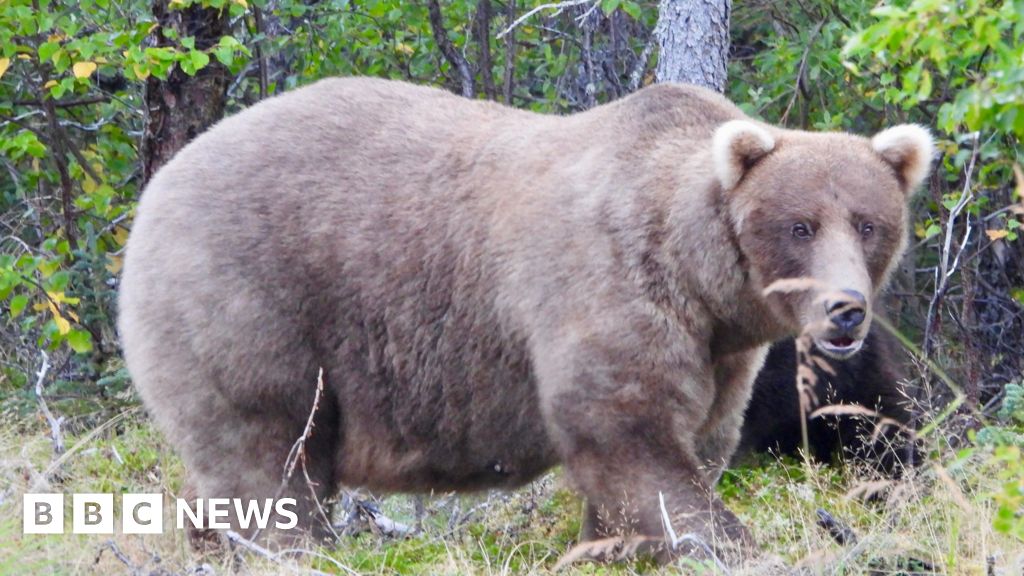
The winner of Fat Bear Week has finally been crowned – and she’s no stranger to the title.
Voters chose 128 Grazer, a mother bear who won Fat Bear Week last year, and whose cub was recently killed by her last remaining opponent in the competition, 32 Chunk.
The competition, which started a decade ago, allows viewers to watch live cameras of Alaska’s Katmai National Park and Preserve and pick their favourite brown bear after the animals have beefed up on salmon in preparation for winter.
In a post on X, explore.org, the nature network that runs the contest, said 128 Grazer was “the first working mom to ever be crowned champion”.
In July, two of Grazer’s cubs were swept over a waterfall, where Chunk – the most dominant bear on the river – attacked them both, according to explore.org. One later succumbed to its injuries.
The two bears were later pitted against each other in Fat Bear Week’s competition, with Grazer eventually coming out on top, winning more than double Chunk’s votes with more than 71,000 votes.
A highly defensive mother bear, the 20-year-old Grazer is raising her third litter.
“Her fearless nature is respected by other bears who often choose to give her space instead of risking a confrontation. This elevates Grazer’s rank in the bear hierarchy above almost all bears except for the largest males,” her bear profile states.
Fat Bear Week came after a grisly series of events this year. The beginning of the contest was delayed by one day after a female bear was killed by a male bear on camera.
Each year, 12 bears are chosen for the Fat Bear Week bracket and fans can vote online to decide the winner.
Grazer also beat Chunk in 2023, when nearly 1.4 million votes were cast from more than 100 countries, according to Katmai Conservancy and explore.org.
Science & Environment
This test could reveal whether gravity is subject to quantum weirdness


How can we test whether gravity is quantum?
AndreusK/Getty Images/iStockphoto
Though physicists have competing ideas of what quantum gravity could be like, they have yet to definitively determine whether the gravity that we experience is quantum at all. A new proposal lays out a way to dispute or affirm this by observing whether a quantum object’s state is affected when its gravity is measured.
Physicists have repeatedly shown that tiny objects are subject to quantum effects, but for large objects whose behaviour is highly affected by gravity – with black holes being the most extreme example – the same…
Science & Environment
Swedish battery giant Northvolt says head of main plant to step down
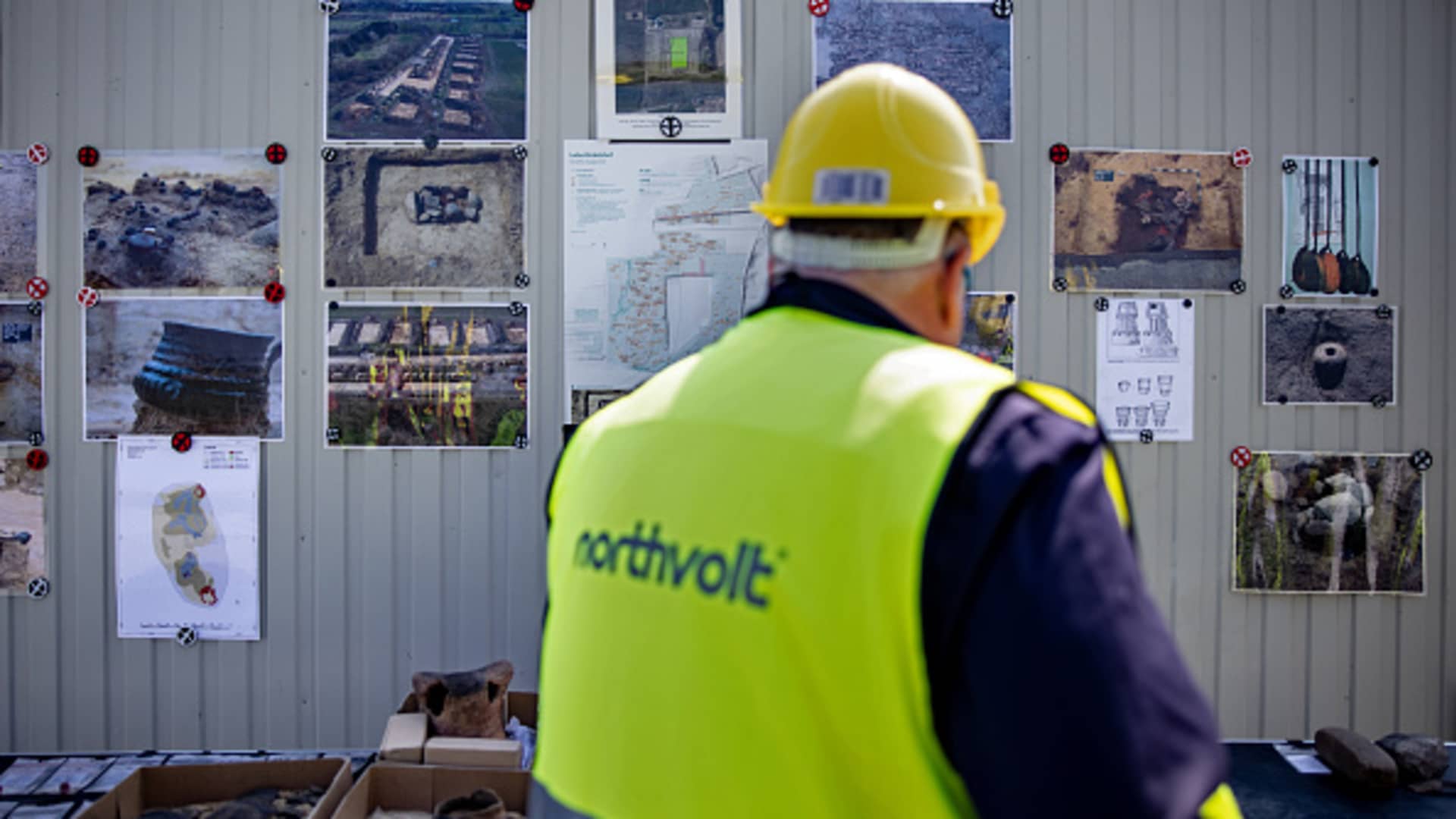
Employees of the State Archaeological Office have hung pictures of finds from a construction trailer during a main archaeological investigation on the Northvolt site.
Picture Alliance | Picture Alliance | Getty Images
Sweden’s Northvolt on Wednesday said the head of its main plant, Europe’s first homegrown gigafactory for lithium-ion battery cells, will step down with immediate effect.
It comes shortly after the cash-strapped company announced plans to reduce its workforce by about 25% in Sweden as part of a major cost-cutting drive.
Mark Duchesne, CEO of Northvolt Ett, will be replaced on an interim basis by Angéline J. Bilodeau, the firm’s vice president of operations in North America, the company said in a statement.
The position will be held until the end of the year as the company seeks to secure a permanent replacement for CEO of Northvolt Ett, it added.
Based in Stockholm, Sweden, Northvolt is one of Europe’s most valuable privately held tech firms that builds lithium-ion batteries for the electric vehicle industry. It has partnerships with a number of major European automakers, including Volkswagen and Volvo.
In an update published Sept. 23, Northvolt said that following initial steps taken as part of a strategic review, the company had revised its scope of operations in Sweden “to ensure that its resources are focused on accelerating production in large-scale cell manufacturing at Northvolt Ett.”
The strategic action required the company to cut a total of 1,600 jobs in Sweden, Northvolt said.
Workers walk at the site of the Northvolt Ett factory in Skelleftea, north Sweden on February 23, 2022.
Jonathan Nackstrand | Afp | Getty Images
Alongside plans to lay off staff, Northvolt said at the time that it would suspend plans for a sizable expansion of Northvolt Ett, noting the project had been intended to provide an additional 30 gigawatt hours of annual cell manufacturing capacity.
On Tuesday, a Northvolt Ett subsidiary filed for bankruptcy following the decision to suspend the expansion project — an update that underscores the group’s deepening financial struggles.
Separately, Swedish automaker Volvo Cars on Wednesday announced deputy CEO Björn Annwall will step down from his current role as part of a management reshuffle.
The reorganization at Volvo Cars comes shortly after the firm scrapped its near-term goal of selling only electric vehicles, citing a need to be “pragmatic and flexible” amid changing market conditions and cooling demand.
Science & Environment
WTI drifts lower after selloff
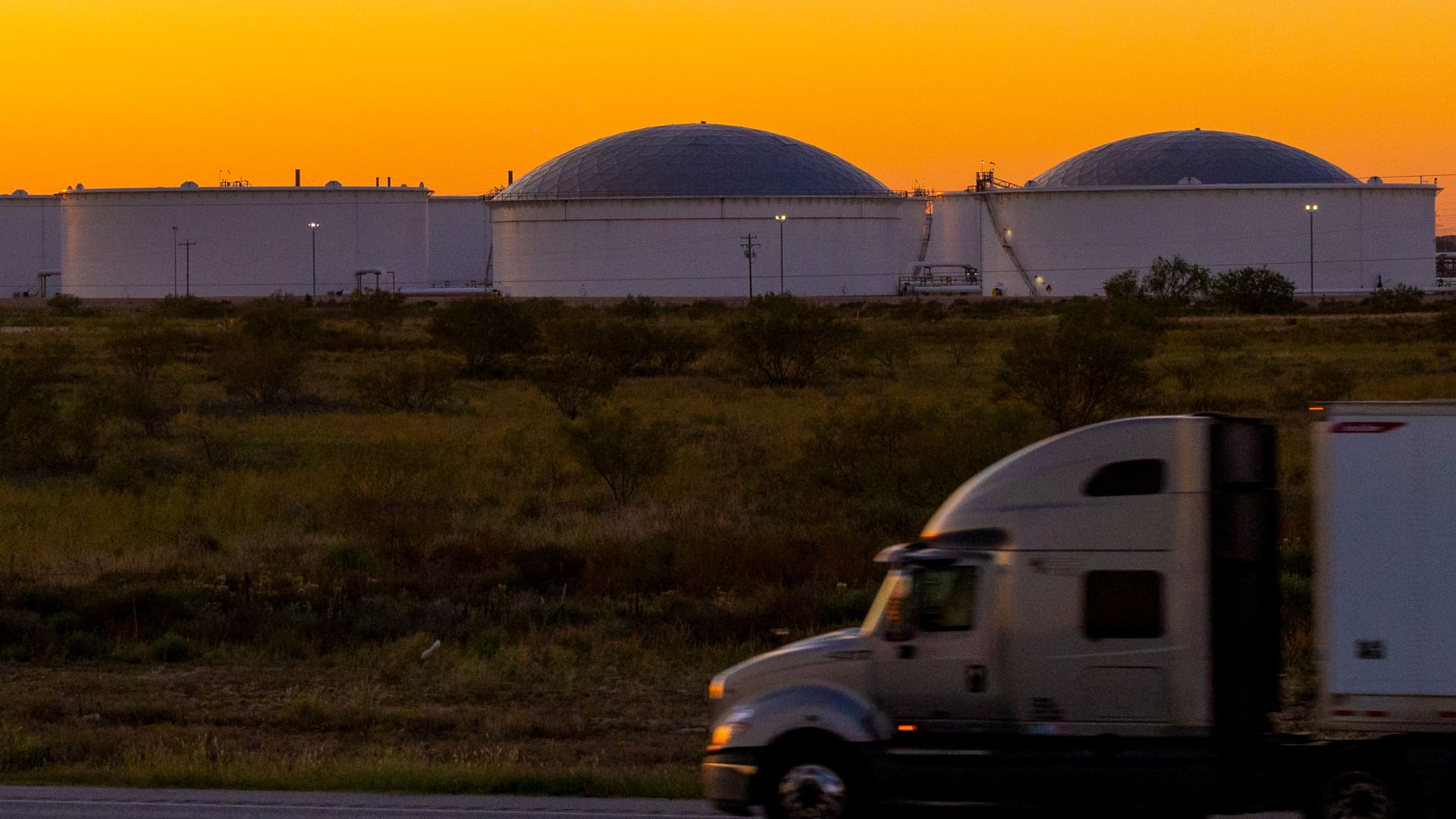

Crude oil futures drifted lower Wednesday after sliding more than 4% the previous day.
The rally spurred by the risk of a wider Middle East war has stalled out amid uncertainty over how Israel will retaliate against Iran for last week’s ballistic missile strike. Chinese policymakers’ failure to deliver new economic stimulus measures at a press briefing this week also held energy prices in check.
Though prices are falling, Goldman Sachs sees global benchmark Brent jumping by $10 to $20 per barrel if an Israeli strike disrupts Iranian crude oil production, according to a Tuesday research note.
Here are Wednesday’s energy prices at around 8:02 a.m. ET:
- West Texas Intermediate November contract: $73.38 per barrel, down 19 cents, or 0.26%. Year to date, U.S. crude oil has gained more than 2%.
- Brent December contract: $77.02 per barrel, down 16 cents, or 0.21%. Year to date, the global benchmark is little changed.
- RBOB Gasoline November contract: $2.0607 per gallon, down 0.36%. Year to date, gasoline has fallen nearly 2%.
- Natural Gas November contract: $2.695 per thousand cubic feet, down 1.39%. Year to date, gas is ahead about 7%.
Science & Environment
Google DeepMind co-founder shares Nobel Chemistry Prize

 BBC
BBC David Baker, Demis Hassabis and John Jumper have won the Nobel Prize for Chemistry for their work on proteins.
Demis Hassabis co-founded the artificial intelligence research company that became Google DeepMind.
The announcement was made by the Royal Swedish Academy of Sciences at a press conference in Stockholm, Sweden.
The winners share a prize fund worth 11m Swedish kronor (£810,000).
This breaking news story is being updated and more details will be published shortly. Please refresh the page for the fullest version.
You can receive Breaking News on a smartphone or tablet via the BBC News App. You can also follow @BBCBreaking on Twitter to get the latest alerts.
-

 Science & Environment3 weeks ago
Science & Environment3 weeks agoHyperelastic gel is one of the stretchiest materials known to science
-

 Womens Workouts2 weeks ago
Womens Workouts2 weeks ago3 Day Full Body Women’s Dumbbell Only Workout
-

 Science & Environment3 weeks ago
Science & Environment3 weeks agoHow to unsnarl a tangle of threads, according to physics
-

 Technology3 weeks ago
Technology3 weeks agoWould-be reality TV contestants ‘not looking real’
-

 Science & Environment3 weeks ago
Science & Environment3 weeks agoMaxwell’s demon charges quantum batteries inside of a quantum computer
-

 Science & Environment3 weeks ago
Science & Environment3 weeks ago‘Running of the bulls’ festival crowds move like charged particles
-

 Science & Environment3 weeks ago
Science & Environment3 weeks agoHow to wrap your mind around the real multiverse
-

 Science & Environment3 weeks ago
Science & Environment3 weeks agoSunlight-trapping device can generate temperatures over 1000°C
-

 News3 weeks ago
News3 weeks agoOur millionaire neighbour blocks us from using public footpath & screams at us in street.. it’s like living in a WARZONE – WordupNews
-
News3 weeks ago
the pick of new debut fiction
-

 Science & Environment3 weeks ago
Science & Environment3 weeks agoITER: Is the world’s biggest fusion experiment dead after new delay to 2035?
-

 Science & Environment3 weeks ago
Science & Environment3 weeks agoLiquid crystals could improve quantum communication devices
-

 Science & Environment3 weeks ago
Science & Environment3 weeks agoQuantum ‘supersolid’ matter stirred using magnets
-

 Science & Environment3 weeks ago
Science & Environment3 weeks agoQuantum forces used to automatically assemble tiny device
-

 Science & Environment3 weeks ago
Science & Environment3 weeks agoPhysicists are grappling with their own reproducibility crisis
-

 Science & Environment3 weeks ago
Science & Environment3 weeks agoLaser helps turn an electron into a coil of mass and charge
-

 Science & Environment3 weeks ago
Science & Environment3 weeks agoWhy this is a golden age for life to thrive across the universe
-

 Science & Environment3 weeks ago
Science & Environment3 weeks agoCaroline Ellison aims to duck prison sentence for role in FTX collapse
-

 Science & Environment3 weeks ago
Science & Environment3 weeks agoTime travel sci-fi novel is a rip-roaringly good thought experiment
-

 News3 weeks ago
News3 weeks agoYou’re a Hypocrite, And So Am I
-

 Science & Environment3 weeks ago
Science & Environment3 weeks agoNuclear fusion experiment overcomes two key operating hurdles
-

 Sport3 weeks ago
Sport3 weeks agoJoshua vs Dubois: Chris Eubank Jr says ‘AJ’ could beat Tyson Fury and any other heavyweight in the world
-
Business2 weeks ago
Eurosceptic Andrej Babiš eyes return to power in Czech Republic
-

 News3 weeks ago
News3 weeks ago▶️ Hamas in the West Bank: Rising Support and Deadly Attacks You Might Not Know About
-

 Science & Environment3 weeks ago
Science & Environment3 weeks agoNerve fibres in the brain could generate quantum entanglement
-

 News3 weeks ago
News3 weeks ago▶️ Media Bias: How They Spin Attack on Hezbollah and Ignore the Reality
-

 Science & Environment2 weeks ago
Science & Environment2 weeks agoX-rays reveal half-billion-year-old insect ancestor
-

 Technology2 weeks ago
Technology2 weeks ago‘From a toaster to a server’: UK startup promises 5x ‘speed up without changing a line of code’ as it plans to take on Nvidia, AMD in the generative AI battlefield
-

 Football2 weeks ago
Football2 weeks agoFootball Focus: Martin Keown on Liverpool’s Alisson Becker
-

 Science & Environment3 weeks ago
Science & Environment3 weeks agoRethinking space and time could let us do away with dark matter
-

 MMA2 weeks ago
MMA2 weeks agoConor McGregor challenges ‘woeful’ Belal Muhammad, tells Ilia Topuria it’s ‘on sight’
-

 Science & Environment3 weeks ago
Science & Environment3 weeks agoA slight curve helps rocks make the biggest splash
-
Business2 weeks ago
Should London’s tax exiles head for Spain, Italy . . . or Wales?
-

 News3 weeks ago
News3 weeks agoNew investigation ordered into ‘doorstep murder’ of Alistair Wilson
-

 Science & Environment3 weeks ago
Science & Environment3 weeks agoA new kind of experiment at the Large Hadron Collider could unravel quantum reality
-

 Science & Environment3 weeks ago
Science & Environment3 weeks agoFuture of fusion: How the UK’s JET reactor paved the way for ITER
-

 Science & Environment3 weeks ago
Science & Environment3 weeks agoWhy we need to invoke philosophy to judge bizarre concepts in science
-

 Science & Environment3 weeks ago
Science & Environment3 weeks agoUK spurns European invitation to join ITER nuclear fusion project
-

 News3 weeks ago
News3 weeks agoIsrael strikes Lebanese targets as Hizbollah chief warns of ‘red lines’ crossed
-

 Technology2 weeks ago
Technology2 weeks agoQuantum computers may work better when they ignore causality
-

 CryptoCurrency3 weeks ago
CryptoCurrency3 weeks agoCardano founder to meet Argentina president Javier Milei
-
News3 weeks ago
The Project Censored Newsletter – May 2024
-

 News3 weeks ago
News3 weeks agoWhy Is Everyone Excited About These Smart Insoles?
-

 Science & Environment2 weeks ago
Science & Environment2 weeks agoMeet the world's first female male model | 7.30
-

 News2 weeks ago
News2 weeks agoFour dead & 18 injured in horror mass shooting with victims ‘caught in crossfire’ as cops hunt multiple gunmen
-

 Womens Workouts2 weeks ago
Womens Workouts2 weeks ago3 Day Full Body Toning Workout for Women
-

 Technology2 weeks ago
Technology2 weeks agoRobo-tuna reveals how foldable fins help the speedy fish manoeuvre
-

 Technology2 weeks ago
Technology2 weeks agoGet ready for Meta Connect
-

 Health & fitness2 weeks ago
Health & fitness2 weeks agoThe 7 lifestyle habits you can stop now for a slimmer face by next week
-

 Sport2 weeks ago
Sport2 weeks agoWatch UFC star deliver ‘one of the most brutal knockouts ever’ that left opponent laid spark out on the canvas
-

 Technology3 weeks ago
Technology3 weeks agoThe ‘superfood’ taking over fields in northern India
-

 Health & fitness3 weeks ago
Health & fitness3 weeks agoThe maps that could hold the secret to curing cancer
-

 Science & Environment3 weeks ago
Science & Environment3 weeks agoA tale of two mysteries: ghostly neutrinos and the proton decay puzzle
-

 CryptoCurrency3 weeks ago
CryptoCurrency3 weeks agoLow users, sex predators kill Korean metaverses, 3AC sues Terra: Asia Express
-
Politics3 weeks ago
UK consumer confidence falls sharply amid fears of ‘painful’ budget | Economics
-

 Womens Workouts3 weeks ago
Womens Workouts3 weeks agoBest Exercises if You Want to Build a Great Physique
-

 Womens Workouts3 weeks ago
Womens Workouts3 weeks agoEverything a Beginner Needs to Know About Squatting
-

 TV3 weeks ago
TV3 weeks agoCNN TÜRK – 🔴 Canlı Yayın ᴴᴰ – Canlı TV izle
-

 Science & Environment3 weeks ago
Science & Environment3 weeks agoCNN TÜRK – 🔴 Canlı Yayın ᴴᴰ – Canlı TV izle
-

 Servers computers2 weeks ago
Servers computers2 weeks agoWhat are the benefits of Blade servers compared to rack servers?
-

 Technology2 weeks ago
Technology2 weeks agoIs sharing your smartphone PIN part of a healthy relationship?
-
Business3 weeks ago
JPMorgan in talks to take over Apple credit card from Goldman Sachs
-

 Health & fitness3 weeks ago
Health & fitness3 weeks agoThe secret to a six pack – and how to keep your washboard abs in 2022
-

 Science & Environment3 weeks ago
Science & Environment3 weeks agoQuantum time travel: The experiment to ‘send a particle into the past’
-

 Science & Environment3 weeks ago
Science & Environment3 weeks agoBeing in two places at once could make a quantum battery charge faster
-

 CryptoCurrency3 weeks ago
CryptoCurrency3 weeks agoBitcoin miners steamrolled after electricity thefts, exchange ‘closure’ scam: Asia Express
-

 CryptoCurrency3 weeks ago
CryptoCurrency3 weeks agoDorsey’s ‘marketplace of algorithms’ could fix social media… so why hasn’t it?
-

 CryptoCurrency3 weeks ago
CryptoCurrency3 weeks agoDZ Bank partners with Boerse Stuttgart for crypto trading
-

 CryptoCurrency3 weeks ago
CryptoCurrency3 weeks agoBitcoin bulls target $64K BTC price hurdle as US stocks eye new record
-

 News3 weeks ago
News3 weeks agoChurch same-sex split affecting bishop appointments
-

 CryptoCurrency3 weeks ago
CryptoCurrency3 weeks agoBlockdaemon mulls 2026 IPO: Report
-

 Sport3 weeks ago
Sport3 weeks agoUFC Edmonton fight card revealed, including Brandon Moreno vs. Amir Albazi headliner
-

 CryptoCurrency3 weeks ago
CryptoCurrency3 weeks agoEthereum is a 'contrarian bet' into 2025, says Bitwise exec
-

 News2 weeks ago
News2 weeks agoUS Newspapers Diluting Democratic Discourse with Political Bias
-

 Technology2 weeks ago
Technology2 weeks agoThe best robot vacuum cleaners of 2024
-
Business1 week ago
Ukraine faces its darkest hour
-

 Politics3 weeks ago
Politics3 weeks agoTrump says he will meet with Indian Prime Minister Narendra Modi next week
-

 CryptoCurrency3 weeks ago
CryptoCurrency3 weeks agoDecentraland X account hacked, phishing scam targets MANA airdrop
-

 CryptoCurrency3 weeks ago
CryptoCurrency3 weeks agoRedStone integrates first oracle price feeds on TON blockchain
-

 Science & Environment3 weeks ago
Science & Environment3 weeks agoHow one theory ties together everything we know about the universe
-

 CryptoCurrency3 weeks ago
CryptoCurrency3 weeks ago‘No matter how bad it gets, there’s a lot going on with NFTs’: 24 Hours of Art, NFT Creator
-

 Science & Environment3 weeks ago
Science & Environment3 weeks agoHow do you recycle a nuclear fusion reactor? We’re about to find out
-

 Science & Environment3 weeks ago
Science & Environment3 weeks agoTiny magnet could help measure gravity on the quantum scale
-
Business3 weeks ago
Thames Water seeks extension on debt terms to avoid renationalisation
-

 CryptoCurrency3 weeks ago
CryptoCurrency3 weeks agoCoinbase’s cbBTC surges to third-largest wrapped BTC token in just one week
-
Business3 weeks ago
How Labour donor’s largesse tarnished government’s squeaky clean image
-
Politics3 weeks ago
‘Appalling’ rows over Sue Gray must stop, senior ministers say | Sue Gray
-

 Technology3 weeks ago
Technology3 weeks agoiPhone 15 Pro Max Camera Review: Depth and Reach
-

 News3 weeks ago
News3 weeks agoBrian Tyree Henry on voicing young Megatron, his love for villain roles
-

 News3 weeks ago
News3 weeks agoBrian Tyree Henry on voicing young Megatron, his love for villain roles
-

 MMA3 weeks ago
MMA3 weeks agoRankings Show: Is Umar Nurmagomedov a lock to become UFC champion?
-

 Travel2 weeks ago
Travel2 weeks agoDelta signs codeshare agreement with SAS
-

 Politics2 weeks ago
Politics2 weeks agoHope, finally? Keir Starmer’s first conference in power – podcast | News
-

 CryptoCurrency3 weeks ago
CryptoCurrency3 weeks agoLouisiana takes first crypto payment over Bitcoin Lightning
-

 CryptoCurrency3 weeks ago
CryptoCurrency3 weeks agoCrypto scammers orchestrate massive hack on X but barely made $8K
-

 Science & Environment3 weeks ago
Science & Environment3 weeks agoMost accurate clock ever can tick for 40 billion years without error
-

 CryptoCurrency3 weeks ago
CryptoCurrency3 weeks agoSEC asks court for four months to produce documents for Coinbase
-

 CryptoCurrency3 weeks ago
CryptoCurrency3 weeks ago‘Silly’ to shade Ethereum, the ‘Microsoft of blockchains’ — Bitwise exec
-
Politics3 weeks ago
No 10 fears ICC will ask UK to sign Benjamin Netanyahu arrest warrant | Israel-Gaza war
-

 Womens Workouts3 weeks ago
Womens Workouts3 weeks agoHow Heat Affects Your Body During Exercise


You must be logged in to post a comment Login